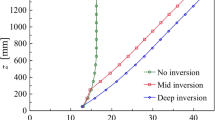Summary
Nonlinear interactions and feedbacks in frontal dynamics are studied with two-dimensional quasigeostrophic, semigeostrophic and primitive equation models for given cases of moderate surface cold fronts. According to the degree of approximation these feedbacks are in effect as a result of geostrophic and ageostrophic advection configuring the further frontal development and the associated energy-transfers between the geostrophic and the ageostrophic scales. The most prominent feedback processes, including the feedback connected with the ageostrophic along-front windv ag , are theoretically reviewed. In cases of smallv ag values, their effects on form and horizontal scale of the frontal secondary circulation are discussed by comparing the products of different model versions and the cross-frontal spectral analysis of the ageostrophic wind fields. To scrutinize the role played by thev ag -field, further experiments were based on a hierarchy ofv ag -substitutes parameterized by the momentum equation of the crossfrontal winddu/dt=fv ag . Tentative results show the tendency towards very localized effects.
Similar content being viewed by others
References
Andrews, D. G., Hoskins, B. J., 1978: Energy spectra predicted by semi-geostrophic theories of frontogenesis.J. Atmos. Sci.,35, 509–512.
Blumen, B., 1980: A Comparison between the Hoskins-Bretherton model of frontogenesis and the analysis of an intense surface frontal zone.J. Atmos. Sci.,37, 64–77.
Davies, H. C., Müller, J. C., 1988: Detailed description of deformation-induced semigeostrophic frontogenesis.Quart. J. Roy. Meteor. Soc.,114, 1201–1219.
Egger, J., Schmid, S., 1988: Elimination of spurious inertial oscillations in Boundary-Layer Models with time dependent geostrophic winds.Bound.-Layer Meteor.,43, 393–401.
Gall, R. L., Williams, R. T., Clark, T. L., 1987: On the minimum scale of surface fronts.J. Atmos. Sci.,44, 2562–2574.
Garner, S. T., 1989a: Fully Lagrangian numerical solutions of unbalanced frontogenesis and frontal collapse.J. Atmos. Sci.,46, 717–739.
Garner, S. T., 1989b: Comments on “On a theory of the evolution of surface cold fronts”.J. Atmos. Sci.,46, 1872–1873.
Garner, S. T., 1991: The nongeostrophic structure of baroclinic waves and its relation to fronts and jet streaks.J. Atmos. Sci.,48, 147–162.
Hoinka, K. P., Volkert, H., Heimann, D., 1988: The German front experiment 1987: Observations and preliminary results. Deutsche Forschungs-und Versuchsanstalt für Luft-und Raumfahrt, Oberpfaffenhofen, Forschungsbericht DFVLR-FB 88-21.
Hoskins, B., 1975: The geostrophic momentum approximation and the semigeostrophic equations,J. Atmos. Sci.,32, 233–242.
Hoskins, B., 1978: Section B: Baroclinic instability and frontogenesis. In: Roberts, P. H., Soward, A. M. (eds.)Rotating Fluids in Geophysics. Academic Press, London, pp. 171–203.
Hoskins, B. J., 1982: The mathematical theory of frontogenesis.Ann. Rev. Fluid Mech.,14, 131–151.
Hoskins, B. J., Bretherton, F. P., 1972: Atmospheric frontogenesis models: Mathematical formulation and solution.J. Atmos. Sci.,29, 11–37.
Hoskins, B., Draghici, I., 1977: The forcing of ageostrophic motion according to the semigeostrophic equations in an isentrophic coordinate model.J. Atmos. Sci.,34, 1859–1867.
Hsie, E. Y., Anthes, R. A., Keyser, D., 1984: Numerical simulation of frontogenesis in a moist atmosphere.J. Atmos. Sci.,41, 2581–2594.
Keyser, D., Pecnick, M. J., 1985a: A two-dimensional primitive equation model of frontogenesis forced by confluence and horizontal shear.J. Atmos. Sci.,42, 1259–1282.
Keyser, D., Pecnick, M. J., 1985b: Diagnosis of ageostrophic circulation in a two-dimensional primitive equation model of frontogenesis.J. Atmos. Sci.,42, 1283–1305.
Keyser, D., Pecnick, M. J., 1987: The Effect of along-front temperature variation in a two-dimensional primitive equation model of surface frontogenesis.J. Atmos. Sci.,44, 511–604.
Kerkmann, J., 1990: Simulation orographisch beeinflusster fronten mit einem Front-Skala-Model, Teil 2. Dissertation, Meteorologisches Institut der Universität Bonn.
Keuler, K., 1989: Simulation orographisch beeinflusster Fronten mit einem Front-Skala-Model, Teil 1. Dissertation, Meteorologisches Institut der Universität Bonn.
Levy, G., Bretherton, C. S., 1987: On a theory of the evolution of surface cold fronts.J. Atmos. Sci.,44, 3413–3418.
Ley, B. E., Peltier, W. R., 1978: Wave generation and frontal collapse.J. Atmos. Sci.,35, 3–17.
Montgomery, M. T., Farrell, B. F., 1990: Dry surface frontogenesis arising from interior potential vorticity perturbations in a semigeostrophic model.J. Atmos. Sci.,47, 2837–2852.
Müller, J. C., 1989: Semigeostrophische Entwicklung von Fronten und Störungen in der unteren Atmosphäre. Dissertation Nr. 8878, Eidgenössische Technische Hochschule Zürich.
Ogura, Y., Portis, D., 1982: Structure of the cold front observed in SESAM-AVE III and its comparison with the Hoskins-Bretherton frontogenesis model.J. Atmos. Sci.,39, 2773–2792.
Orlanski, I., Ross, B. B., 1977: The circulation associated with a cold front. Part I: Dry case.J. Atmos. Sci.,34, 1619–1633.
Orlanski, I., Ross, B. B., 1984: The evolution of an observed cold front. Part II: Mesoscale dynamics.J. Atmos. Sci.,41, 1669–1703.
Orlanski, I., Ross, B. B., Polinsky, L., Shaginaw, R., 1985: Advances in the theory of atmospheric fronts.Adv. Geophys.,28b, 223–252.
Reeder, M. J., Keyser, D., 1988: Balanced and unbalanced upper-level-frontogenesis.J. Atmos. Sci.,45, 3366–3386.
Reeder, M. J., Smith, R., 1987: A study of frontal dynamics with application of the Australian summertime “cool change”.J. Atmos. Sci.,44, 687–705.
Sanders, F., 1955: An Investigation of the structure and dynamics of an intense surface frontal zone.J. Meteor.,12, 542–552.
Shapiro, R., 1971: The use of linear filtering as a parameterization of atmospheric diffusion.J. Atmos. Sci.,28, 523–531.
Thorpe, A. J., Clough, S. A., 1991: Mesoscale dynamics of cold fronts: structures described by dropsoundings in fronts 87.Quart. J. Roy. Meteor. Soc.,117, 903–941.
Author information
Authors and Affiliations
Additional information
With 10 Figures
Rights and permissions
About this article
Cite this article
Gabriel, A., Schilling, H.D. Effects of different approximations in 2D-front-scale models on cross frontal structures (weakv ag -case). Meteorl. Atmos. Phys. 51, 1–24 (1993). https://doi.org/10.1007/BF01080877
Received:
Revised:
Issue Date:
DOI: https://doi.org/10.1007/BF01080877



